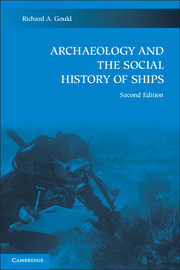Book contents
- Frontmatter
- Contents
- List of figures
- List of tables
- Acknowledgments
- Introduction: Toward a higher standard
- 1 Interpreting the underwater archaeological record
- 2 Underwater archaeology: The state of the art
- 3 Ships and shipwrecks: Basic mechanics
- 4 The archaeology of small watercraft
- 5 The earliest ships
- 6 Shipwrecks and our understanding of ancient trade
- 7 Sailing ships of the Middle Ages
- 8 Ships of the great age of sail
- 9 From sail to steam in maritime commerce
- 10 New technologies and naval warfare
- 11 The archaeology of maritime infrastructure
- 12 The future of shipwreck archaeology
- References cited
- General index
- Ship and site index
4 - The archaeology of small watercraft
Published online by Cambridge University Press: 05 June 2012
- Frontmatter
- Contents
- List of figures
- List of tables
- Acknowledgments
- Introduction: Toward a higher standard
- 1 Interpreting the underwater archaeological record
- 2 Underwater archaeology: The state of the art
- 3 Ships and shipwrecks: Basic mechanics
- 4 The archaeology of small watercraft
- 5 The earliest ships
- 6 Shipwrecks and our understanding of ancient trade
- 7 Sailing ships of the Middle Ages
- 8 Ships of the great age of sail
- 9 From sail to steam in maritime commerce
- 10 New technologies and naval warfare
- 11 The archaeology of maritime infrastructure
- 12 The future of shipwreck archaeology
- References cited
- General index
- Ship and site index
Summary
Because the remains of early watercraft are often found in saturated soils and peat bogs, the archaeological record tends toward overrepresentation of log and wood-plank boats. These are better preserved than watercraft made of skins, reeds, or other, more perishable materials (McGrail, 1981: 6). Sometimes this bias can be overcome to a degree by use of documentary and iconographic information, although such representations often lack detail and may be inaccurate. The biggest problem with the archaeology of small watercraft has been the tendency to resort to conjectural history to overcome the limitations and gaps imposed by the archaeological record. There are serious questions about the use of ethnographic analogies in the attempt to understand ancient boatbuilding and use (McGrail, 1998: 3). Their value to archaeology was succinctly summarized by Muckelroy (1978: 236) as providing a wider range of possibilities for assessing how particular boat technologies may have been used than experimental reconstructions or computer-generated simulations. The archaeology of boats and early ships has come a long way, however, since Muckelroy's time, and today archaeological evidence can support more empirically grounded analysis and interpretations.
Ephemeral Watercraft
The earliest direct archaeological evidence for small boats is a birchwood paddle preserved in peat and mud deposits at the site of Star Carr, a roughly 8,000-year-old Mesolithic campsite in northeastern England (Clark, 1954: 23; Fig. 77, Plate 21).
- Type
- Chapter
- Information
- Archaeology and the Social History of Ships , pp. 91 - 120Publisher: Cambridge University PressPrint publication year: 2011



